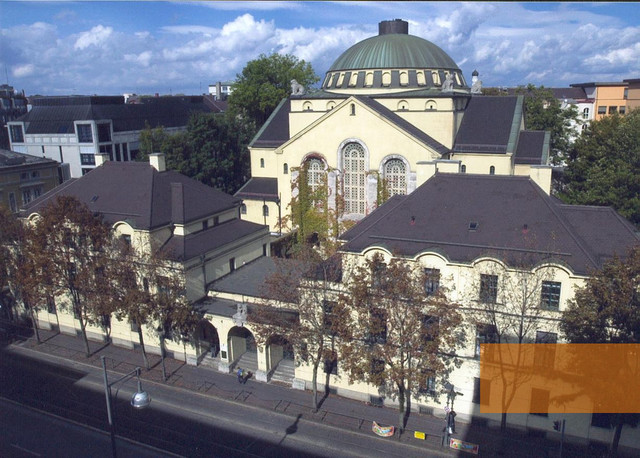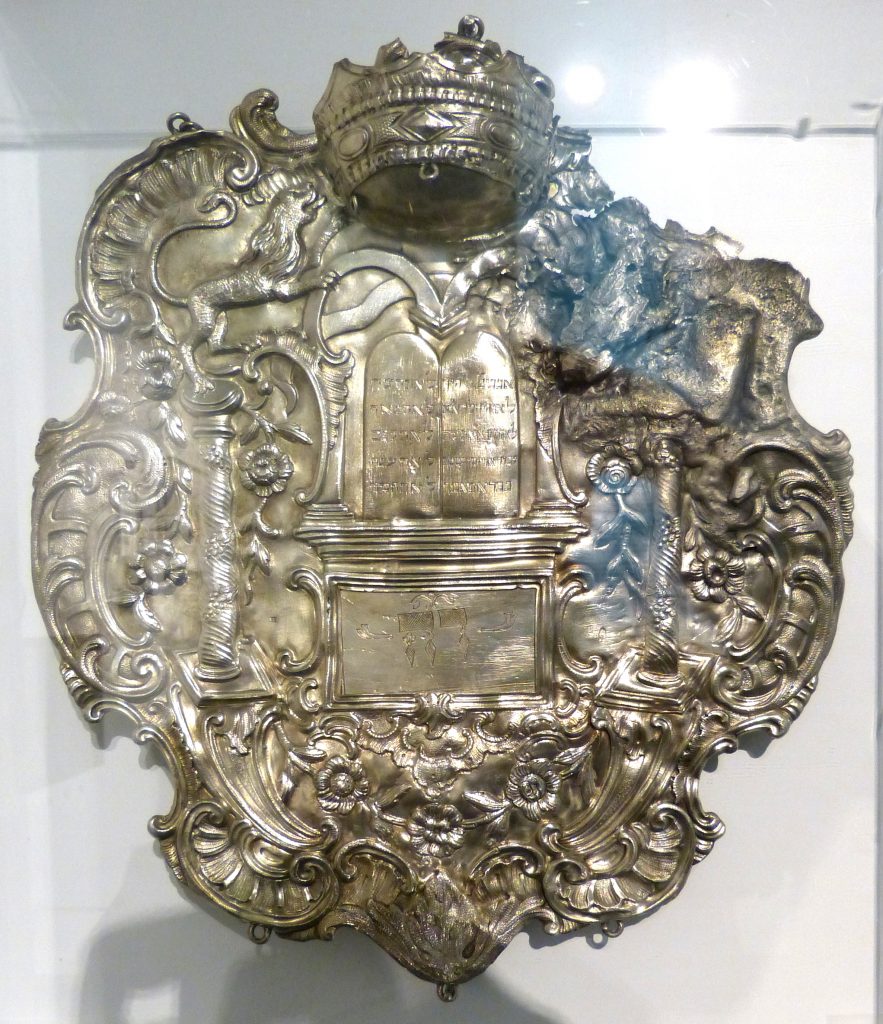Archaeologists have discovered an oil lamp dating from the 4th century. A menorah was found on it. Documentary evidence of Jews living in Augsburg dates from 1212. Records from the second half of the 13th century show a well-organized community, and mention the Judenhaus (1259), the synagogue and cemetery (1276), the ritual bathhouse, and “dancehall” for weddings (1290).

Development and persecutions
The Jews were mainly occupied as vintners, cattledealers, and moneylenders. Until 1436, lawsuits between Christians and Jews were adjudicated before a mixed court of 12 Christians and 12 Jews. In 1298 and 1336 the Jews of Augsburg were saved from massacre through the intervention of the municipality. During the Black Death (1348–49), many were massacred and the remainder expelled from the city. The emperor granted permission to the bishop and burghers to readmit them in 1350 and 1355, and the community subsequently recovered to some extent.
Later, however, it became so impoverished by the extortions of the emperor that the burghers could no longer see any profit in tolerance. In 1434–36 Jews in Augsburg were forced to wear the yellow badge. The community, then numbering about 300 families, dissolved within a few years; by 1340 the last Jews had left Augsburg. Thereafter, Jews were only permitted to visit Augsburg during the day on business. They were also granted the right of asylum in times of war.

In the late Middle Ages, the Augsburg yeshivah made an important contribution to the development of the pilpul method of study and analysis of the Talmud. The variant of the pilpul method evolved in Augsburg is referred to as the “Augsburg ḥillukim.” The talmudist Jacob Weil lived in Augsburg between 1412 and 1438. While some Hebrew pamphlets were printed in Augsburg by as early as 1514, a Hebrew press was established in 1532.
Organizing the Jewish community
An organized Jewish community was again established in Augsburg in 1803. Jewish bankers settled there by agreement with the municipality in an endeavor to redress the city’s fiscal deficit. In practice, the anti-Jewish restrictions in Augsburg were eliminated in 1806, with the abrogation of the city’s special status and its incorporation into Bavaria; however, the new Jewish civic status was not officially recognized until 1861. In 1871, Augsburg was the meeting place of a rabbinical assembly dealing with liturgical reform. The Jewish population increased from 56 in 1801 to 1,156 in 1900. It numbered 1,030 in 1933. In 1938, the magnificent synagogue dedicated in 1917 was burned down by the Nazis. In late 1941, after emigration and flight to other German cities, the last 170 Jews were herded into a ghetto, with 129 of them sent to Piaski in Poland in April 1942 and the rest mostly to the Riga ghetto and Theresienstadt. In the immediate postwar period, a camp was established in Augsburg to house displaced Jews. A few weeks after the liberation, services were resumed in the badly damaged synagogue by survivors of the Holocaust and Jewish soldiers of the U.S. Army, and the community was eventually reestablished. The synagogue was restored and rededicated in 1985. As a result of the immigration of Jews from the Former Soviet Union, the number of community members rose from 199 in 1989 to 1,619 in 2003.
The Synagogue
In 1861, the community received the government’s authorization to build a synagogue. The construction began in March 1864, and the official inauguration took place on April 7, 1865. Quickly, this building became too small, and in 1900 it was decided that a bigger synagogue had to be built. Its construction began in 1914, but the outbreak of the First World War significantly delayed the work that ended in 1917 due to a lack of workers and materials.

Designed by Fritz Landauer et D. Heinrich Lömpel, the synagogue is magnificently built in the late Jugendstil (Art Nouveau) style while fitting perfectly into the baroque style of the city. Above the roof, on both sides of the dome, sit two lions, a symbol of the tribe of Judah. The whole building is 27 meters long and 27 meters wide. The height is 27 meters to the lamppost on the dome. The cupola has a diameter of 16 meters. The shape of the windows with their stone filigree pattern and the shape of the cupola emphasize its oriental inspiration. Almost 800 places are available for men and women who are separated.
On the keystone of the door of the Hall of Columns, sculptor Walter Sebastian Resch engraved the date 1298 with a Star of David and the arms of the city to commemorate the city’s centuries-old relationship with the Jewish community. In the courtyard, a marble ornamental pond supported by animal sculptures is fed by a spring. A sentence in Hebrew on the basement mentions, “May all those who are thirsty come, here flows the spring”. The houses of the rabbi and the cantor, the administrative offices, and the school, as well as a small prayer room for the working days, are located in the two buildings overlooking the street.
After the inauguration of the new synagogue in 1917, the old synagogue in Wintergasse closed. The building was then used as headgear. It was completely destroyed during the Second World War.
During Kristallnacht, the synagogue was set on fire. Fortunately, the neighboring inhabitants, feared that the fire would spread to their homes and to kerosene tanks at a nearby petrol station, called firefighters who quickly extinguished the arson. The structure of the synagogue has therefore not suffered.
During the Second World War, the synagogue was used to store the sets of the municipal theater, while the Jewish school building was occupied by the Air Force Staff. The dome of the synagogue serves as an observation post for anti-aircraft defense artillery.

After 1945, the buildings are returned to the Jewish community. In 1964, the small synagogue is again inaugurated. Renovations started in 1975 and ended in 1985. On 1 September 1985, the synagogue was again inaugurated by an office in the presence of more than 120 members of the former community of Augsburg from around the world. At the same time, the Jewish Cultural Museum opened its doors in a part of the building. The latter was extensively renovated in 2005-2006.
The Jewish museum
At the same address, the Jewish Museum was founded in 1985. It documents the rich culture and history of the Jews in Augsburg and Swabia from the Middle Ages to the present.
The new permanent exhibition, installed in November 2006, presents this history as a story of migration and focuses on the relationship between the Jewish minority and the Christian majority. It also depicts the changes in religious practice in the course of time, showing Jewish history as an integral part of Augsburg and Swabian history. You will find a kosher coffee shop in the museum.
The Jewish cemetery
The cemetery was opened in 1867 and is presently still in use. Note however, that due to repeated vandalism, the cemetery is kept closed except for burials or announced visitors. The cemetery contains about 1500 graves.
Sources: Encyclopaedia Judaica ; Wikipedia ; Jewish Museum of Augsburg